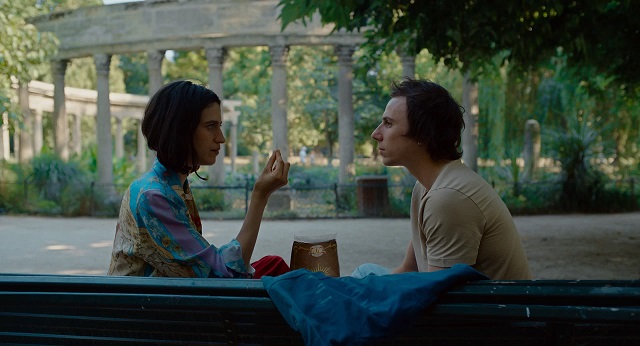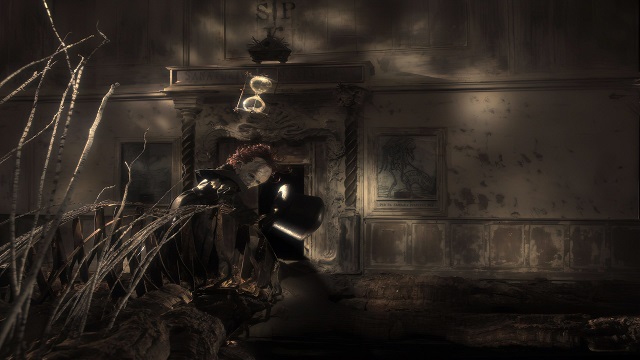I vincitori della terza edizione del Premio Cinema & Arts
Miglior film: Riefensthal di Andres Veiel e Paul & Paulette Take a Bath di Jethro Massey. Miglior artista multiumediale: The Quay Brothers (wtih the reasons for the Awards, in English)
I VINCITORI DEL PREMIO CINEMA & ARTS
in occasione della 81° Mostra Internazionale di Arte Cinematografica La Biennale di Venezia
MIGLIOR FILM
RIEFENSTAHL di Andres Veiel
PAUL & PAULETTE TAKE A BATH di Jethro Massey
MIGLIOR ARTISTA MULTIDISCIPLINARE
QUAY BROTHERS

La premiazione: Oliviero Ponte di Pino, Alessio Nardin, Antonio Giuseppe Bia
Sono stati assegnati nel pomeriggio del 5 settembre 2024, all’Hotel Excelsior del Lido di Venezia, i premi della terza edizione di “Cinema&Arts”, ideato da Alessio Nardin e organizzato e curato da Kalambur Teatro e Associazione Culturale Ateatro.
Il premio si focalizza sull’interazione e la presenza di diverse arti nel cinema contemporaneo e, specie in questo tempo storico, la commistione tra cinema e diverse forme di manifestazioni artistiche, con un occhio di riguardo per la musica e le arti performative dal vivo.
La giuria è composta da Alessio Nardin, Oliviero Ponte di Pino e Antonio Giuseppe Bia, affiancati da un gruppo di allievi del Percorso Triennale per Registi ed Attori della Accademia Eleonora Duse – Centro Sperimentale di Cinema e Arti Performative e da attori dalle masterclass internazionali dell’Accademia Duse.
Nel corso dell’evento sono state proiettare al pubblico della Mostra in prima europea le pellicole The Long Step (USA 2024, 12’) scritto da Paola Calliari e diretto da Michael Sandoval e Strade maestre (Italia 2024, 55’) un film di Sergio Maifredi e Ruggero Torre con Eugenio Barba, Stefan Kaegi, Antonio Latella, Arianne Mnouchkine, Thomas Ostermeier, Milo Rau, Peter Stain, Krzysztof Warlikowski.
LE MOTIVAZIONI DELLA GIURIA
MIGLIOR FILM | BEST MOVIE
RIEFENSTAHL
di Andres Veiel
Produzione Germania (2024) 115’ colore e b&w
Sceneggiatura Andres Veiel
Riefensthal è un docufilm costruito con chirurgica precisione utilizzando interviste televisive, citazioni di altri documentari (come quello di Ray Muller del 1993), ma soprattutto l’archivio privato della stessa Riefensthal.
Questo attento e sapiente intreccio inizialmente si sofferma ed esalta l’arte della celeberrima regista tedesca, partendo dalle immagini di due suoi indiscussi capolavori, Il trionfo della volontà (1934) e Olympia, dedicato alle Olimpiadi di Berlino del 1936. Emergono quindi il talento, la visionarietà e l’avanguardismo, non solo della regista, ma anche della geniale montatrice che, per senso del ritmo e precisione, ha fatto scuola nella storia del cinema occidentale.
Proprio soffermandosi ed insistendo su questa maniacalità, il film ci svela come, passo dopo passo, l’ambizione artistica sfoci anche in quella umana, con tutte le sue contraddizioni, a cominciare dalle sue strette relazioni non solo con Adolf Hitler e il suo ministro della Propaganda Joseph Goebbels (i suoi principali mecenati e sostenitori delle sue fortune artistiche), ma anche e sino in tarda età con ol suo grande amico Albert Speer, l’architetto del Terzo Reich.
- Jospeh Goebberl, Hermann Goering, Leini Riefesnthal
- Leni Riefesthal
Di qui in avanti il film, con una struttura narrativa certosina e raffinata fatta di immagini e interviste distopiche, si sviluppa in un continuo altalenare di posizioni, documentazioni visive e sonore, che esplorano punti di vista contraddittori e ugualmente attendibili (come in Rashomon di Akira Kurosawa), spingendo lo spettatore a interrogarsi su dove sia la verità. In questo raffinato gioco scenico, Andres Veiel dirige ed armonizza immagini, voci e suoni come in un’opera lirica.
La scena finale, davvero magistrale, con l’ultima intervista (interrotta nel film) svela come i temi trattati da Veiel non riguardino tanto la ricerca di una “verità” assoluta sulla vicenda umana della donna Leni, quanto piuttosto la ricerca di ciò che della verità l’artista Riefenstahl ha potuto raccontare, percepire, manipolare e deformare, al punto da ricreare per sé stessa (e forse anche per gli altri) un’altra possibile verità a cui credere fermamente.
- Leni Riefesthal e Adolf Hitler
- Leni Riefesthal e Adolf Hitler
Riefensthal is a docufilm built with surgical precision using television interviews, quotes from other documentaries (such as Ray Muller’s 1993), and above all Riefensthal’s own private archive. This careful and skilful interweaving initially focuses on and exalts the art of the celebrate German director, starting with the images of two of her undisputed masterpieces, Triumph of the Will (1934) and Olympia, dedicated to the 1936 Berlin Olympics Games. The talent, vision and avant-garde here emerge, not only those of the director, but also those of the editor. With her brilliant sense of rhythm and precision, she has set a magistral example in the history of Western cinema. By dwelling and insisting on this meticulous precision, the film reveals to us how, step by step, artistic ambition also flows into human ambition, with all its contradictions, starting with her close relationship with Adolf Hitler and then his Minister of Propaganda Joseph Goebbels (her main patrons and supporters of her artistic fortunes), but also and until late in life with her great friend Albert Speer, the architect of the Third Reich.
From here on, the film, with an attentive and refined narrative structure made of dystopian images and interviews, develops in a continuous swing of positions, visual and sound documentation, which explore contradictory and equally reliable points of view (as in Rashomon by Akira Kurosawa), pushing the viewer to question where the truth lies. In this refined scenic game, Andres Veiel directs and harmonizes images, voices and sounds as in a great opera.
The final scene, truly masterful, shows the last interview (interrupted in the film) and reveals how the themes addressed by Veiel do not so much concern the search for an absolute “truth” on the human story of the woman Leni, but rather the search for what the artist Riefenstahl was able to tell, perceive, manipulate and deform of the truth, to the point of recreating for herself (and perhaps also for others) another possible truth in which to firmly believe.
PAUL & PAULETTE TAKE A BATH
di Jethro Massey
Produzione Gran Bretagna (2024),108’, colore
sceneggiatura Jethro Massey
Paul & Paulette Take a Bath ha per protagonisti due giovani, a partire dalla casualità, quasi assurda, del loro incontro in Place de la Concorde di Parigi. Di qui nasce un’amicizia che si sviluppa attorno a un gioco teatrale: ogni loro incontro è la messinscena di un crimine cruento di epoche passate (che il film evoca con una serie di immagini d’archivio), inscenato nel luogo in cui era avvenuto, con travestimenti e battute, come in un gioco di ruolo o in un copione teatrale.
- Paul & Paulette Take a Bath
- Paul & Paulette Take a Bath
- Paul & Paulette Take a Bath
Incontro dopo incontro il regista, grazie alla precisa struttura del soggetto, svela gradualmente cosa si muove intorno all’apparente casualità iniziale. Per Paul, aspirante fotografo senza fortuna, questo macabro gioco teatrale è la strada per alimentare il gioco della seduzione con quella ragazza misteriosa e affascinate. Per Paulette è invece un tentativo di sfuggire momentaneamente alle difficoltà della sua appassionata relazione con una donna e di provare a elaborare il suo passato familiare. A far emergere in modo diretto e drammatico questo retroscena sarà il viaggio in auto che li porta alla scoperta di sé prima ancora che dell’altro.
Il loro viaggio umano, che diventa sempre più morboso ed assurdo, si avvicina sempre più ad un passato più recente, come in una macchina del tempo, fino a sfumare i confini tra realtà e fantasia, tra ciò che hanno vissuto e ciò che potrebbero vivere.
Ad accompagnare la vicenda, su un livello di azione specifico, è l’arte fotografica, al centro delle aspirazioni di Paul, che trova nel finale e nei titoli di coda il suo compimento con l’archivio privato che documenta questa sgangherata storia d’amore.

Paul & Paulette Take A Bath (Marie Benati)
Da sottolineare la prova attoriale di tutto il cast e in special modo di Marie Benati, che con grande variazione di registri drammatici trascina lo spettatore all’interno della trama e dell’incessante alternarsi di stato d’animo.

Il Premio Cinema & Arts a Paul & Paulette Take A Bath
Paul & Paulette Take a Bath features a young girl and young boy, starting from the almost absurd chance of their first meeting in the Place de la Concorde in Paris. From here a friendship is born that develops around a theatrical game: each of their meetings is the staging of a bloody crime from the past (which the film evokes with a series of archive images), staged in the place where it occurred, with disguises and jokes, like in a role-playing game or a theatrical dramaturgy and its mise en scene. Meeting after meeting the director, thanks to the precise structure of the subject, gradually reveals what is moving around the apparent initial chance. For Paul, an aspiring photographer with no luck, this macabre theatrical play is a way to fuel the game of seduction with that mysterious and fascinating girl. For Paulette, on the other hand, it is an attempt to momentarily escape the difficulties of her passionate relationship with a woman and try to work through her family past. A long car journey that leads them to discover themselves before they discover each other will bring this backstory to light in a direct and dramatic way. Their human journey, on the other hand, which becomes increasingly morbid and absurd, gets closer and closer to a more recent past, as if in a time machine, to the point of blurring the boundaries between reality and fantasy, between what they have experienced and what they could experience. Accompanying the story, on a specific level of action, is photographic art, at the heart of Paul’s aspirations, which finds its fulfillment in the finale and in the credits with the private archive that documents this ramshackle love story. Worth highlighting is the acting performance of the entire cast and especially of Marie Benati. With great variation in dramatic registers, temperament and personality she takes the viewer by the hand and drags him into the plot and the incessant alternation of moods.
MIGLIOR ARTISTA MULTIDISCIPLINARE | BEST MULTIDISCIPLINARY ARTIST
QUAY BROTHERS (USA 1947)
Stephen e Timothy Quay sono due gemelli registi, animatori e scenografi statunitensi, noti per la qualità nell’animazione in stop motion, che ha ispirato diversi altri artisti.
Dopo aver studiato illustrazione e cinema presso il Philadelphia College of Art, sin dagli inizi si cimentano in diverse arti. Si distinguono subito come registi cinematografici, illustratori e scenografi. La maggior parte dei loro film di animazione presenta burattini realizzati con parti di bambole e altri materiali organici o inorganici, spesso parzialmente disassemblati, immersi un’atmosfera tetra e malinconica.
Come scenografi, dal 1988 i fratelli Quay creano ambienti e proiezioni per produzioni di performing art su vari palcoscenici internazionali. Il loro lavoro su piccola scala si allarga spesso in scenografie su larga scala per le produzioni operistiche e teatrali del regista Richard Jones (L’amore delle tre melarance di Prokof’ev, La pulce nell’orecchio di Feydeau, Mazepa di Čajkovskij, Il borghese gentiluomo di Molière). Nel 2016 realizzano la scenografia dell’opera Theatre of the World, presentato alla Walt Disney Concert Hall a Los Angeles e in altri palcoscenici internazionali.
Come illustratori: dopo la realizzazione di copertine per opere letterarie di stampo gotico e fantascientifico a Philadelphia, i gemelli Quay hanno creato suggestivi disegni per un gran numero di pubblicazioni: per le opere di Italo Calvino, Louis-Ferdinand Céline o per lo studio critico di Mark le Fanu sui film di Andrej Tarkovskij.
Le opere dei Quay sono state al centro di diverse mostre personali, come quelle presso l’EYE Film Instituut Nederland di Amsterdam (2014), il Centre de Cultura Contemporània di Barcellona (2014) e La Casa Encendida di Madrid (2015).
- Sanatorium Under the Sign of the Hourglass dei Quay Brothers (76′)
- Sanatorium Under the Sign of the Hourglass dei Quay Brothers (76′)
- Sanatorium. Under The Sign Of The Hourglass
Il loro film Sanatorium. Under The Sign Of The Hourglass, dedicato all’opera di Bruno Schulz, è il frutto di una ricerca e di un percorso produttivo durati ben 19 anni. E’ dunque la piena espressione del loro talento e della loro poliedricità. La raffinata partitura musicale, oltre a essere origine dei movimenti dei puppets, diventa progressivamente insostituibile strumento e linguaggio narrativo nello svilupparsi dei diversi quadri del film. La struttura dell’opera si impernia su una scansione, quasi teatrale di prologo, svolgimento ed epilogo. La parte centrale immerge lo spettatore in un mondo onirico, che non viene simulato, ma creato concretamente, con rara maestria. L’intreccio delle diverse discipline in cui i fratelli Quay sono maestri (scenografia, illustrazione, animazione dei puppets con la presenza di attori in carne e ossa) contribuisce, assieme alle novelle di Schulz, a creare un mondo assurdo ma reale, di inquietante e toccante bellezza.
Stephen and Timothy Quay are two American twin directors, animators and set designers, known for the quality of their stop motion animation, which has inspired several other artists. After studying illustration and cinema at the Philadelphia College of Art, they have been trying their hand at various arts since the beginning. They immediately distinguished themselves as film directors, illustrators and set designers. Most of their animated films feature puppets made from parts of dolls and other organic or inorganic materials, often partially disassembled, immersed in a dark and melancholic atmosphere. As set designers, since 1988 the Quay brothers have created environments and projections for performing art productions on various international stages. Their work as small-scale illustrators often expands into large-scale sets for opera and theater productions by director Richard Jones (Prokofiev’s The Love for Three Oranges, Feydeau’s A Flea in Her Ear, Tchaikovsky’s Mazepa, Molière’s The Bourgeois Gentleman). In 2016, they designed the sets for the opera Theatre of the World, presented at the Walt Disney Concert Hall in Los Angeles and on other international stages. As illustrators: after creating covers for gothic and science fiction literary works in Philadelphia, the Quays have created evocative drawings for a variety of publications, from the works of Italo Calvino and Louis-Ferdinand Céline to Mark le Fanu’s critical study of Andrei Tarkovsky’s films. The Quays’ works have been the focus of several solo exhibitions, such as those at the EYE Film Instituut Nederland in Amsterdam (2014), the Centre de Cultura Contemporània in Barcelona (2014) and La Casa Encendida in Madrid (2015). Their film Sanatorium. Under The Sign Of The Hourglass, dedicated to the work of Bruno Schulz, is the result of 19 years of research and production. It is therefore the full expression of their talent and versatility. The refined musical score, in addition to being the origin of the puppets’ movements, progressively becomes an irreplaceable instrument and narrative language in the development of the film’s various scenes. The structure of the work hinges on an almost theatrical sequence of prologue, development and epilogue. The central part invites the viewer to dive into a dreamlike world, which is not simulated, but created concretely, with rare mastery. The intertwining of the different disciplines in which the Quay brothers are masters (scenography, illustration, puppet animation with the presence of real actors) contributes, together with Schulz’s short stories, to creating an absurd but real world, of disturbing and touching beauty.
Tag: Ateatro in English (8)


















